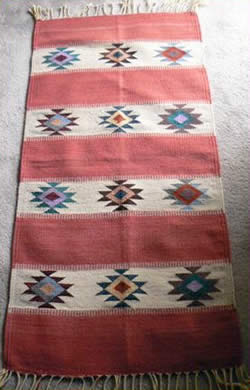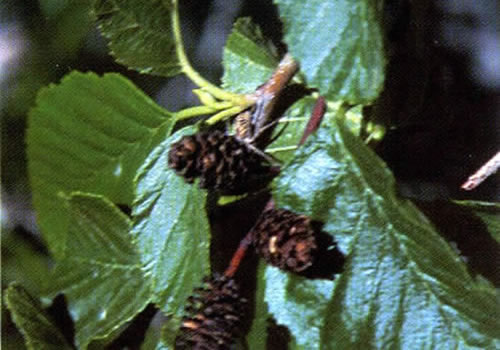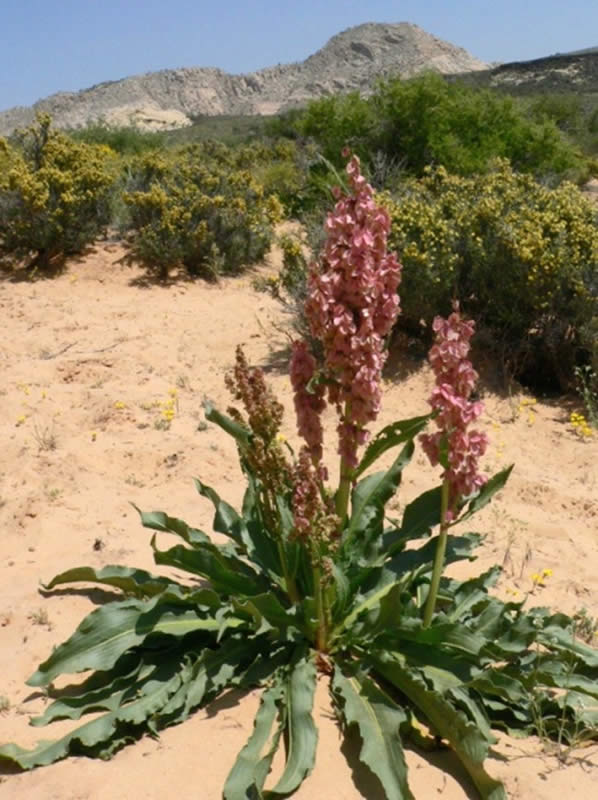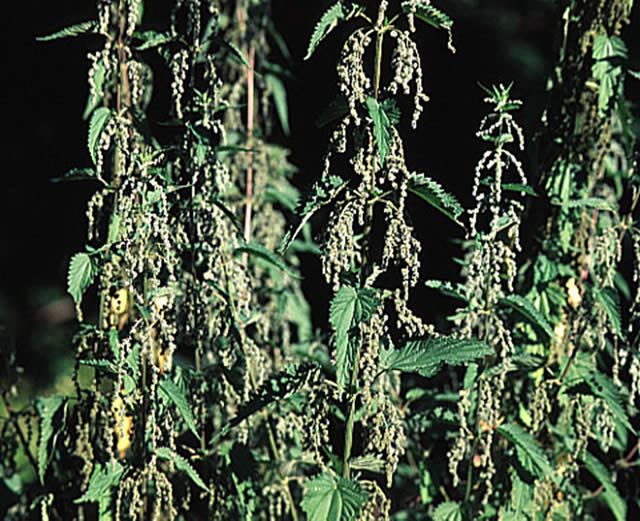Native Plant Dyes

Plants have been used for natural dyeing since before recorded history. The staining properties of plants were noted by humans and have been used to obtain and retain these colors from plants throughout history. Native plants and their resultant dyes have been used to enhance people's lives through decoration of animal skins, fabrics, crafts, hair, and even their bodies.
Types of Dyes
Natural dye materials that produce durable, strong colors and do not require the addition of other substances to obtain the desired outcome are called substantive or direct dyes. Sumac (Rhus spp.) and walnut (Juglans spp.) are native plant examples of direct dyes. Because these species are high in tannic acid, they do not require additional substances to be added for the dye to attach to fibers and form a durable bond. Dyes that need this type of assistance are called adjective or mordant dyes.
Mordants
Mordants are water-soluble chemicals, usually metallic salts, which create a bond between dye and fiber thus increasing the adherence of various dyes to the item being dyed. The actual color one gets from a natural dye depends not only on the source of the dye but also on the mordant, and the item being dyed.
Most mordant recipes also call for the addition of cream of tartar or tartaric acid. Use of this readily available spice is important because it reduces fiber stiffness that can occur because of mordanting. It can also increase brightness.
| Mordant | Effect |
|---|---|
| Alum | Brightens the colors obtained from a dye source |
| Iron/Coppers | Darkens/saddens hues, produces blacks, brown, gray |
| Copper vitriol | Improves likelihood of obtaining a green hue |
| Tin | Produces bright colors especially yellows, oranges, reds |
| Chrome | Highly toxic – should not be used for dyeing at home |
Plants Used for Dyes
Throughout the world, evidence of natural dyeing in many ancient cultures has been discovered. Textile fragments dyed red from roots of an old world species of madder (Rubia tinctoria) have been found in Pakistan, dating around 2500 BC. Similar dyed fabrics were found in the tombs of Egypt.
 Finely woven Hopi wicker plaques made from rabbitbrush and sumac stems colored with native and commercial dyes. Photo by Teresa Prendusi.
Finely woven Hopi wicker plaques made from rabbitbrush and sumac stems colored with native and commercial dyes. Photo by Teresa Prendusi.
 Mordants can be used to increase color intensity such as in this Southwestern–style rug. Photo by Teresa Prendusi.
Mordants can be used to increase color intensity such as in this Southwestern–style rug. Photo by Teresa Prendusi.
- Tyrean purple dye was discovered in 1500 B.C. and was produced from the glandular secretions of a number of mollusk species.
- This purple dye was extremely expensive to produce as it required nearly 12,000 mollusks to produce 3.5 ounces of dye.
- Tyrean purple became the color of royalty.
- Lichens were used to produce ochril, a purple dye, which was called the “poor person’s purple”.
Native North American Plants Used for Dyes
European settlers in North America learned from Native Americans to use native plants to produce various colored dyes (see Table 2).
| PLANT | Number of Uses |
|---|---|
| Mountain Alder | 53 |
| Red Alder | 21 |
| Bloodroot | 20 |
| Rubber rabbitbrush | 16 |
| Smooth sumac | 16 |
| Canaigre dock | 14 |
| Eastern cottonwood | 13 |
| Black walnut | 12 |
| Skunkbrush sumac | 11 |
| Butternut | 9 |
 Bloodroot (Sanguinaria canadensis). Photo by Dave Moore.
Bloodroot (Sanguinaria canadensis). Photo by Dave Moore.
Bloodroot (Sanguinaria canadensis)
Bloodroot (Sanguinaria canadensis) was used to produce red dyes. Green dyes were made from algae and yellow dyes were made from lichens. Early colonists discovered that colors produced by the Native Americans quickly faded, thus suggesting that mordants may not have been used.
 Mountain alder (Alnus incana).
Mountain alder (Alnus incana).
Mountain alder (Alnus incana)
This small, riparian tree has been used by many native tribes to make a brown, red-brown, or orange-red dye to darken hides, stain bark used in basketry and dye porcupine quills. Inner bark was used to make yellow dye. Outer bark was used to make a flaming red hair dye. Some tribes mixed this species with grindstone dust or black earth to make a black dye. Bark was used to wash and restore the brown color to old moccasins.
In the western United States, various layers of red alder bark, Alnus rubra, yield red, red-brown, brown, orange, and yellow dyes. These colors have been used to stain baskets, hides, moccasins, hair, quills, fishnets, canoes, cloth, and other items.
 Smooth sumac (Rhus glabra), an important dye plant, with fall colors.
Smooth sumac (Rhus glabra), an important dye plant, with fall colors.
Smooth sumac (Rhus glabra)
This deciduous shrub is a widely distributed throughout most of the contiguous United States. It is readily recognized by its thicket-forming habit, milky sap, compound leaves, and dense, terminal panicles of bright red drupes. A variety of dye colors can be obtained from different parts of the plant depending on the mordant used.
The leaves are rich in tannin and can be used as a direct dye. Leaves can be collected as they fall in the autumn and used as a brown dye. The twigs and root are also rich in tannin. A black and a red dye can be obtained from the fruit. A black dye is obtained from the leaves, bark, and roots. An orange or yellow dye is obtained from the roots harvested in spring. A light yellow dye is obtained from the pulp of the stems.
Butternut (Juglans cinerea)
This tree native to the eastern United States was important as a food and dye source. Native Americans used the bark to make a brown dye and young roots to make a black dye. Using an iron mordant, brown dye can be changed to a charcoal or gray color.
- The famous gray coats that the Confederate Army wore during the Civil War were colored with dye made from butternuts.
- Confederate soldiers were called “butternuts” because of their dyed uniforms.
Rubus
The genus Rubus belongs to the rose family. Common names include raspberry, blackberry, blackcap, and thimbleberry. Varieties of blackberry include dewberry, boysenberry, and loganberry. This group consists of erect, arching or trailing, deciduous and evergreen shrubs found wild in Europe, North America, and Asia.
These berries are actually aggregate fruits, which means they are composed of individual drupelets, held together by almost invisible hairs. Some berry canes may be armed with formidable spines and make great security hedges, while others may be nearly spineless. All parts of the blackberry plant (berries, leaves, canes) yield dye colors.
| Dye Color | Plant Common Name (Additional Colors) |
|---|---|
| Yellow Dyes | Yarrow (green, black) |
| Honey Locust | |
| Golden wild-indigo (green) | |
| Tall cinquefoil (black, green, orange, red) | |
| Pecan (brown) | |
| Indiangrass (brown, green) | |
| Orange Dyes | Western comandra (brown, yellow) |
| Prairie Bluets (brown, yellow) | |
| Bloodroot (brown, yellow) | |
| Sassafras (black, green, purple, yellow) | |
| Eastern Cottonwood (black, brown, yellow) | |
| Plains Coreopsis (black, green, yellow, brown) | |
| Red Dyes | Ozark chinkapin (black, yellow, brown) |
| Sumac (yellow, green, brown, black) | |
| Chokecherry | |
| Prairie Parsley (yellow, brown) | |
| Slippery Elm (brown, green, yellow) | |
| Black Willow (black, green, orange, yellow) | |
| Purple / Blue Dyes | Indian blanket (black, green, yellow) |
| Hairy coneflower (brown, green, yellow, black) | |
| Red Mulberry (brown, yellow, green) | |
| Mountain alder (brown, red, orange) | |
| Summer Grape (orange, yellow, black) | |
| Black Locust (black, green, yellow, brown) | |
| Green Dyes | Butterfly milkweed (yellow) |
| Texas Paintbrush (green, red, yellow) | |
| Basket flower (yellow) | |
| Sagebrush (yellow, gray) | |
| Stinging nettle | |
| Goldenrod (yellow, brown) | |
| Gray Dyes | Iris (black) |
| Butternut (brown) | |
| Canaigre Dock (yellow, green, brown) | |
| Brown Dyes | Prickly poppy (green, orange, yellow) |
| Texas Paintbrush (green, red, yellow) | |
| Elderberry (yellow) | |
| Downy Phlox (brown, green, yellow) | |
| Black Dyes | Northern Catalpa (brown, yellow) |
| Sumac (yellow, red, green, brown) | |
| May-apple (brown, yellow) | |
| Sand Evening Primrose (green, orange, red, yellow) |
Did You Know?
- The tissues of canaigre dock (Rumex hymenosepalus) - a southwest desert native plant used to make yellow, gray or green dye, and widely noted for its medicinal, edible, and social uses - contain toxic oxalate. The needlelike crystals produce pain and edema when touched by lips, tongue or skin.
- Eastern cottonwood used to make a variety of dyes was a sign to early pioneers that they were near water. Ribbons of cottonwoods were found across the prairie where underground watercourses were located.
- Prior to chemical synthesis of indigo dye, blue jeans and cotton were dyed with a blue dye derived from tropical indigo bush, native to India. Mayo indigo, from the Sonoran desert was used for blue dye for thousands of years.
- Rubber rabbitbrush, a western native, can be used to create both green and yellow dyes. The bark produces green dye while flowers produce yellow dye.
- Not only is stinging nettle edible, it can be used to create a green dye. Stinging nettle can cause severe skin irritation, but is useful for dyes, fiber, and food.
For More Information
- Native American Ethnobotany Database - explore more about native plants used for natural dyes.
- Making Natural Dyes from Plants - examine some readily available natural plant dyes.





